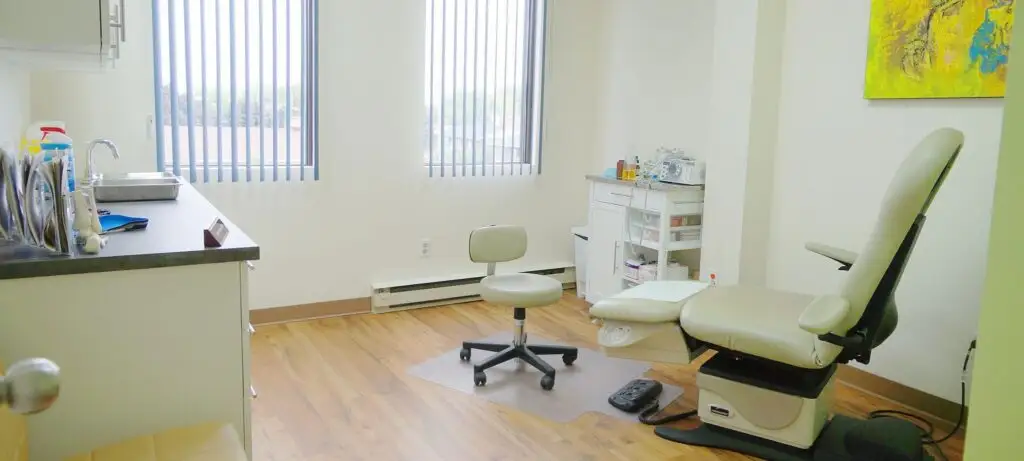Dr. Alexandra Nguyen, Podiatrist, is a doctoral student in podiatry at the Université du Québec à Trois-Rivières since 2009. Her primary focus is to treat her patients with courtesy and compassion. To accomplish this, she uses all the knowledge she has acquired in her training, particularly that acquired at the New York College of Podiatric Medicine.
Dr. Nguyen performs important outreach work to ensure that patients fully understand the causes of their pain and the treatments needed to manage it. This way, the treatment becomes more effective and you will be able to relieve pain in your feet, ankles, knees or lower back more quickly.
PiedRéseau St-Hubert
5110 Boulevard Cousineau #305,
Saint-Hubert, QC J3Y 7G5
directions
1-450 678-0881 Toll free
Monday
8:30 - 18:30
Tuesday
8:30 - 18:30
Wednesday
8:30 - 18:30
Thursday
8:30 - 16:00
Friday
9:00 - 16:00
Nous serons fermé du 22 décembre 2025 au 02 janvier 2026. Nous serons de retour le 05 janvier 2026. Passez de joyeuses fêtes de fin d'année!
A soothing and welcoming clinic
The Clinique podiatrique de la Montée is the very first podiatry clinic to open in the city of St-Hubert. Its services are covered by most insurance plans, and no medical referral is required for a consultation. And they offer service without unnecessary delay.
Owner and podiatrist Alexandra Nguyen founded the Clinique podiatrique de La Montée in 2009. Since then, she has been welcoming her patients in a welcoming and highly professional setting. Her goal is to ensure that every patient who walks through the door of the Clinique de La Montée feels that they are listened to, understood and treated with care.


Frequent problems
- Big toe osteoarthritis (Hallux rigidus)
- Corns, calluses and severe corns
- Diabetic foot ulcer : symptoms and treatments
- Foot arthritis : symptoms and treatments
- Foot blisters : symptoms and treatments
- Foot bunion (hallux valgus)
- Functional hallux limitus
- Heel spur (Lenoir’s thorn)
- Hematoma under the toenail
- Ingrown toenail (onychocryptosis)
- Joint wear and tear : symptoms and treatments
- Osteoarthritis of the knee
- Pain : foot, ankle, leg, knee, hip and lower back
- The bunionette (quintus varus)
- Toenail trauma : symptoms and treatments
Treatments provided
- 2D and 3D digital imaging
- Biomechanical exam : symptoms and treatments
- Cortisone injections
- Evaluating Children’s Feet
- Foot care – Nails, corns and calluses treatment
- Manual foot therapy : personalized treatment plan
- Nail culture : importance, advantages and procedure
- Plantar orthotics: types, benefits, and adaptation tips
- Podopediatrics treatments
- ShockWave therapy : therapeutic benefits and treatment
- Stress fracture in the foot
- Therapeutic foot taping
- Treating frostbite on the feet and toes
- Treatment for excessive foot sweating
- Treatment of foot pain by the podiatrist
- Ingrown toenail treatment by a podiatrist
- A podiatrist’s treatment for plantar warts
- Toenail deformity : treatments
- Treatments for paronychia of the toe
- Partial or complete foot amputation
- Ultrasound treatment
- Orthopaedic shoes : types and benefits
Surgical procedures offered
Responsible for personal information/confidentiality: Alexandra Nguyen 450-812-6117
Request an appointment at the clinic
Leave us your contact details and availability and we will contact you to make an appointment.
Please note that if you are seeking podiatry services following a work-related accident (CNESST) or a road accident (SAAQ), please contact us before your appointment to obtain more information about the reimbursement procedures.

